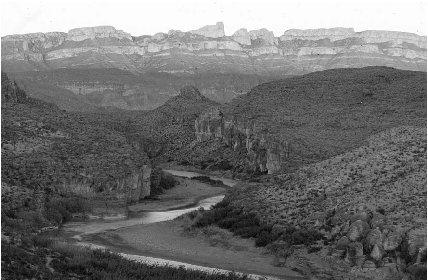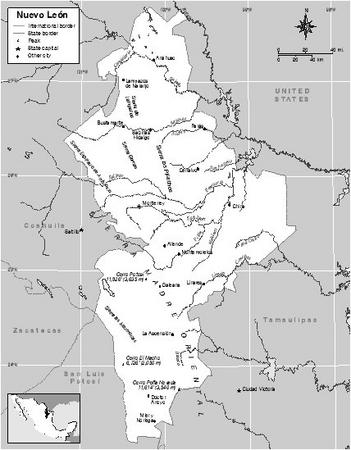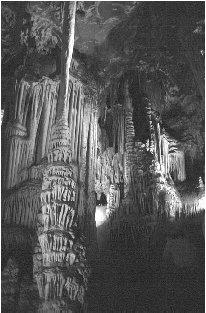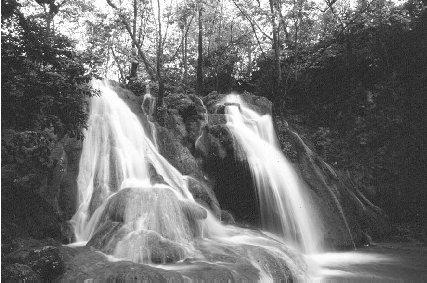Nuevo León

Pronunciation: noo-WAY-voh-lay-OWN.
Origin of state name: Nuevo León was named in honor of the Spanish kingdom of León.
Capital: Monterrey (mohn-teh-REH-ee).
Entered country: 1824.
Coat of Arms: The coat of arms of Nuevo León is made up by four squares. At the top, six bees represent the hard-working nature of the local citizens. The upper left square features a picture of the sun over La Silla Hill (a landmark that often symbolizes the state), with an orange tree. In the upper right-hand square, a crowned lion is ready to attack. In the lower left, there is a picture of the San Francisco convent. On the lower-right, five smoking chimneys represent industry. The weapons around the border represent both native warriors and Spanish conquerors. The banner displays the state motto, Sempre Ascendens, which means "always rising."
Holidays: Año Nuevo (New Year's Day—January 1); Día de la Constitución (Constitution Day—February 5); Benito Juárez's birthday (March 21); Primero de Mayo (Labor Day—May 1); Revolution Day, 1910 (November 20); and Navidad (Christmas—December 25).
Flag: There is no official state flag.
Time: 6 AM = noon Greenwich Mean Time (GMT).
1 Location and Size
Nuevo León is located in northern Mexico. It covers an area of 64,556 square kilometers (24,925 square miles), or about half the size of the US state of New York. It is bordered on the north and east by the Mexican state of Tamaulipas. The Río Bravo (or Río Bravo del Norte) separates the northern tip of Nuevo León from the US state of Texas. This river is known as the Río Grande in the United States. On the south, the state is bordered by the Mexican states of Tamaulipas and San Luis Potosí, and on the west by the Mexican states of Coahuila, Zacatecas, and San Luis Potosí. Nuevo León has fifty-one municipalities. The capital is Monterrey.
The Sierra Madre Oriental, one of Mexico's major mountain ranges, crosses the state. A series of caves near Monterrey known as Grutas de García are accessible to the public.
The most important river in Nuevo León is the San Juan, which flows 121 kilometers (75 miles) northeast into Tamaulipas.

The Río Bravo (or Río Bravo del Norte) separates the northern tip of Nuevo León from the US state of Texas. This river is known as the Río Grande in the United States.
2 Climate
The state has an extreme range of temperatures, but for most of the year the climate is generally hot. In the north, the climate is hot and dry. In the central region, by the Sierra Madre, temperatures are cooler. In the south, the climate is dry and desert-like.
In Monterrey, the lowest recorded temperature was about 0° c (32° f ) and the highest was 44° c (111° f ). On average, the temperature in Monterrey is above ° c (80° f ) for about 238 days each year. The average temperatures for the entire state are a minimum of about 17° c (62° f ) and a maximum of 23° c (74° f ). Average precipitation for the state ranges from a minimum of 20 centimeters (8 inches) to a maximum of 100 centimeters (39 inches).
3 Plants and Animals
Natural pastures and thickets cover some of the dry, low-altitude regions of the state. Forests of pine and oak trees can be found in areas with a greater level of

4 Environmental Protection
Environmental concerns for the state include maintaining an adequate safe water supply and properly managing hazardous waste materials. There are four national parks in the state, including the Cumbres de Monterrey National Park.
5 Population, Ethnic Groups, Languages
In 2000, Nuevo León had a total population of 3,834,141; of the total, 1,907,939 were men and 1,926,202 were women. The population density was 60 people per square kilometer (155 people per square mile). In 2000, the capital, Monterrey, had a population of 1,108,499. Almost all citizens speak Spanish as their first language. Less than 1% of the population speaks indigenous (native) languages.
6 Religions
According to the 2000 census, 78% of the population, or about three million people, were Roman Catholic; about 6%, or 211,402 people, were Protestant. That year there were also 10,403 Seventh-Day Adventists, 10,563 Mormons, 46,150 Jehovah's Witnesses, and 665 Jews. Almost 100,000 people reported no religion.
7 Transportation
Monterrey Airport provides international flights to and from Nuevo León. The state has about 8,664 kilometers (5,381 miles) of roads and 1,096 kilometers (681 miles) of railroads.
8 History
There is scattered anthropological and archeological evidence of early nomad and hunter and gatherer indigenous groups during the first centuries of the Christian era. Yet, when the Spaniards arrived, there were no large human settlements in the region. Most of the native population was comprised of nomadic groups that traveled through the unfriendly Nuevo León terrain.
The first conquistadors (those who sought to conqueror Mexico for the Spanish crown) to visit the region were Alvar Nuñez Cabeza de Vaca (c. 1490-c. 1560) around 1535 and Andrés de Olmos around 1545. In 1575, Alberto del Canto found a valley that he called Extremadura, where the city of Monterrey was later founded. Further north, he found the mineral deposits of San Gregorio. In 1579, King Felipe II (1527–1598) of Spain granted Luis Carvajal y de la Cueva the authorization to conquer those territories. Three years later, Carvajal initiated his expedition and founded the San Luis de Francia settlement. In the early 16th century, Diego de Montemayor was named governor of the region and he led a new colonization effort. Franciscan priests joined Montemayor with the intention of converting the indigenous population to Catholic faith. However, colonization efforts were mostly abandoned by the late 16th century.
During the 16th century, Tlaxacala Indians were sent to help the colonization efforts and to help nomadic tribes learn the advantages of permanent settlements. Because of the lack of accessible cheap labor and the vast territorial extensions, cattle ranching became the most important economic activity in the region during the colonial period. The need to combat nomadic tribes, however, made it costly for cattle ranchers to consolidate their businesses. In the mid 1700s there was a short-lived mining fever resulting from the discovery of gold and silver mines. The mines were rapidly exploited to their limits and the fever subsided. During the late 1700s, Catholic convents and seminaries were built in the region, taking advantage of the large land entitlements given to the church and because population density remained low.
The independence movement caught on for a short period of time in Nuevo León in 1811. But after the execution of the extremely popular and powerful priest and revolutionary Miguel de Hidalgo y Costilla (1753–1811), the independence revolts were brought to a halt. Royalist forces, loyal to Spain, then regained control of the entire region. After the adoption of the Plan of Iguala in 1821, Nuevo León became a province of independent Mexico. Starting in 1824 it was made into a federal state, and a new state constitution was promulgated.
Political instability characterized much of the 19th century. First, conflicts between centralists and federalists, and later, civil war between liberals and conservatives, prevented the economic development of the region. These continuing conflicts regularly threw social order into turmoil in Monterrey and other towns. The consolidation of a liberal regime after Mexico ceded its northern territories, including Texas, to the United States helped bring about much needed economic development. However, low population density remained a problem for Nuevo León. A new railroad between Mexico City and Monterrey helped bring

A series of caves near Monterrey, known as Grutas de García, are accessible to the public.
The Mexican Revolution started early in Nuevo León. Mexican revolutionist Fransciso Indalécio Madero (1873–1913) was arrested in Monterrey in 1910 during his failed presidential campaign. Accusations of fraud by incumbent president Porfirio Díaz (1830–1915) triggered the call for a revolution later that year. Eventually, the revolutionary victors controlled Nuevo León. The state participated in the writing and promulgation of the Mexican Constitution of 1917.

Waterfalls in Nuevo León.
9 State and Local Government
The state governor is elected for a nonrenewable six-year term. The legislature is comprised of a forty-two-seat unicameral (one chamber) congress. Twenty-six deputies are elected from single member districts, and sixteen deputies are elected by proportional representation. Until 1997, the Institutional Revolutionary Party (PRI) had exercised absolute control over the legislature and state governorship. That year, a National Action Party (PAN) candidate won the gubernatorial race. The PRI regained control of the governorship in 2003. But, the alternation in power and the strength of the PAN and PRI have called into play the implementation of separation-of-power and checks-and-balances provisions previously existing in the constitution.
The fifty-one municipalities that comprise Nuevo León hold democratic elections for municipal presidents and council members every three years. Immediate re-election is not allowed. Although some decentralization initiatives are producing positive results, the state still has a long way to go to achieve successful decentralization.
10 Political Parties
The three main political parties in all of Mexico are the Institutional Revolutionary Party (PRI), the National Action Party (PAN), and the Party of the Democratic Revolution (PRD). Although the PRI dominated state politics since the end of the Mexican Revolution, the PAN consolidated as a strong local party in Nuevo León since the mid 1950s. PAN candidates regularly won several municipal government elections. Since Fernando Canales Clariond won the 1997 gubernatorial elections, the PAN consolidated as the largest state party. The PRI gubernatorial victory in 2003 with José Natividad González shows the consolidation of a two party system in the state.
11 Judicial System
The Superior Tribunal of Justice is the highest court in the state. Its members are appointed by the congress from a three-person list submitted by the state governor. The term of appointment is ten years and justices can be re-elected only for an additional ten-year term. Only highly qualified attorneys can be appointed to the high court. A judicial council also plays a role in fostering the development of a high quality justice system. An electoral tribunal and other lower courts are also part of the Nuevo León judicial system.
12 Economy
Nuevo León is the third most industrialized state of Mexico and most residents enjoy a good standard of living. One of its municipalities, San Pedro Garza García, has the highest per capita income in Latin America. Manufacturing accounts for the greatest percentage of the economy at 27%. Service-based companies account for 22% of the economy, followed by trade at 19%, finance and insurance at 15%, transportation and communication at 11%, construction at 3%, agriculture and livestock at 2%, and mining at 1%.
13 Industry
Nuevo León has a diversified industrial structure, which includes oil refining and heavy and light manufacturing. Nuevo León is a leading national producer of iron, steel, and chemicals. There are many large companies manufacturing products in Nuevo León. Cemex (the world's fourth-largest cement company), Bimbo (bakery and pastry), Maseca (food and grains), Banorte (a bank wholly owned by Mexicans), Alestra (telecommunications), Vitro (glass), Hylsa (aluminum), FEMSA (Coca-Cola in Latin America), and Cervecería Cuauhtémoc-Moctezuma (brewers of five beer brands) are all located in Monterrey.
14 Labor
The US Bureau of Labor Statistics reported that Mexican workers saw their wages increase 17%, from $2.09 per hour in 1999 to $2.46 per hour in 2000. (The average US worker earned $19.86 per hour in 2000.) After one year, workers are entitled by law to six days paid vacation. Because of the industry in Nuevo León, workers earn relatively high wages.
15 Agriculture
Nuevo León has three distinct growing regions, the Northern Gulf Coastal Plain, the Sierra Madre Oriental region, and the Highland region. Agricultural products vary by region. The Northern Gulf Coastal Plain produces watermelon, pears, melons, squash, corn, beans, chili peppers, cotton, and avocado. The Sierra Madre Oriental region and the Highland region both produce corn, wheat, avocado, carrots, beans, and potatoes. The Sierra Madre Oriental region also produces green tomatoes, while the Highland region produces onion, squash, and chili peppers.
In the Northern Gulf Coastal Plain the primary livestock are cattle, goats, pigs, sheep, and horses. In the Sierra Madre Oriental region, livestock is predominantly goats and horses. In the Highland region livestock consists mainly of goats.
16 Natural Resources
Mining products include zinc, copper, lime, coal, iron, silver, and barite (used for drilling oil wells).
17 Energy and Power
Almost all of the energy in Mexico is provided by the Federal Electricity Commission (CFE). In February 2002, the CFE introduced new electric rates. For households that use less than 140 kilowatt hours per month, there was no rate increase. (This is about 75% of all households in Mexico, according to CFE). However, in Nuevo León eight major dams in the state provide hydroelectric power and water for irrigation. El Cuchillo Dam on the San Juan provides hydroelectric power to Monterrey.
18 Health
Nuevo Leon has 31 general hospitals, 532 outpatient centers, and 121 surgical centers.
Most of the Mexican population is covered under a government health plan. The IMSS (Instituto Mexicano de Seguro Social) covers the general population. The ISSSTE (Instituto de Seguridad y Servicios Sociales de Trabajadores del Estado) covers state workers.
19 Housing
Over four-fifths of the housing available in the state of Nuevo León is in good repair. Only about 4% is in need of significant upgrading. These homes may not have running water or access to electricity.
20 Education
The system of public education was first started by President Benito Juárez (1806–1872) in 1867. Public education in Mexico is free for students from ages six to sixteen. According to the 2000 census, there were approximately 730,000 school-age students in the state. Many students elect to go to private schools. The thirty-one states of Mexico all have at least one state university. The Universidad de Monterrey is in the capital, Monterrey.
21 Arts
The state of Nuevo León has over twenty-five theaters. A theater group, Teatro Saltimbanque, and a musical group, Música Maestra, perform throughout the state. There are also cultural centers in most cities.
22 Libraries and Museums
There are 282 branches of the national library system in Nuevo León. In the city of Allende, there is a museum of anthropology. In the capital, Monterrey, there is a baseball hall of fame and a tennis hall of fame, which honors Mexican players. Monterrey also has a glass museum, a natural history museum, a railroad museum, a police museum, and a museum of contemporary art.
23 Media
The capital, Monterrey, has four daily newspapers: Diario de Monterrey, El Norte, El Porvenir, and Milenio.
24 Tourism, Travel, and Recreation
There is a park based on the television series Sesame Street. Birds and butterflies native to the Western Sierra Madre region thrive in the habitat of Chipinque Park. Visitor can also hike and go rock climbing there.
25 Sports
Monterrey's basketball team, the Fuerza Regia, plays in the 4,200-seat Gimnasio Nuevo León. The minor league baseball team, Sultanes de Monterrey, plays in the 27,000-seat Estadio Monterrey. There are two soccer teams in the state. The Reyados Monterrey, play in the 38,622-seat Tecnológico. The Tigres play in the 45,000-seat Universitario stadium. The León soccer team plays in the 33,943-seat Nou Camp stadium.
26 Famous People
Alfonso Reyes (1889–1959) was born in Monterrey. He was a diplomat and a teacher and was considered to be one of the greatest Spanish American writers of his time. One of his most famous prose poems was Visión de Anáhuac.
27 Bibliography
Books
DeAngelis, Gina. Mexico. Mankato, MN: Blue Earth Books, 2003.
Hernández, Marie Theresa. Delirio—The Fantastic, the Demonic, and the Reél: The Buried History of Nuevo León. Austin: University of Texas Press, 2002.
Mora-Torres, Juan. The Making of the Mexican Border. Austin: University of Texas Press, 2001.
Supples, Kevin. Mexico. Washington, DC: National Geographic Society, 2002.
Web Sites
Mexico for Kids. http://www.elbalero.gob.mx/index_kids.html (accessed on June 15, 2004).
Nuevo Léon. http://www.tourbymexico.com/nvoleon/nvoleon.htm (accessed June 17, 2004).
thank you for your help